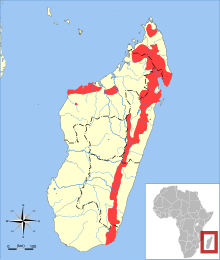Eastern falanouc
| Eastern falanouc | |
|---|---|

| |
| Scientific classification | |
| Domain: | Eukaryota |
| Kingdom: | Animalia |
| Phylum: | Chordata |
| Class: | Mammalia |
| Order: | Carnivora |
| Suborder: | Feliformia |
| Family: | Eupleridae |
| Genus: | Eupleres |
| Species: | E. goudotii
|
| Binomial name | |
| Eupleres goudotii Doyère, 1835
| |

| |
| Eupleres range | |
The eastern falanouc (Eupleres goudotii) is a rare mongoose-like mammal in the carnivoran family Eupleridae endemic to Madagascar .[3]
It is classified alongside the
It lives primarily in the lowland rainforests of eastern Madagascar, while E. major is found in northwest Madagascar. It is solitary and territorial, but whether nocturnal or diurnal is unknown. It is small (about 50 centimetres long with a 24-centimetre-long tail) and shy (clawing, not biting, in self-defence). It most closely resembles the mongooses with its long snout and low body, though its colouration is plain and brown (most mongooses have colouring schemes such as striping, banding, or other variations on the hands and feet).
Its
"Falanoucs are threatened by habitat loss, humans, dogs and an introduced competitor, the small Indian civet (Viverricula indica)."[5]
Viverricula indica are also carnivores, and they had much spatial and temporal overlap with Eupleres goudotii when introduced to the same ecosystem the Eupleres goudotii were in. This overlap has shown to potentially have a negative impact on native carnivore populations such as the Eupleres goudotii because of the two species competing for similar resources.[6]
References
Sources
- Macdonald, David (ed). The Encyclopedia of Mammals. (New York, 1984)
External links
- Eupleres goudotii - Animal Diversity Web
- Images and Video - ARKive.org

